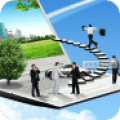Ali's seven-step sales rule?
1、第一步骤:充分的准备
充分的准备包括四个方面的准备,首先是体力的准备。要想让自己体力好,就必须做一些体力上的训练。以我十几年来研究成功学的经验,总结出了一些行之有效的方法(见《自己就是一座宝藏》),现在介绍几个给大家。
一个是每天做一四二深呼吸,早、中、晚各10次,共30次;
二是永远只吃七、八分饱;
三是吃水果在饭前吃,不要在饭后吃;
四是做运动要做有氧运动,比如散步、游泳、慢跑、骑自行车等。
第二是专业知识的准备。你必须对你的产品有非常足够的了解。第三是对顾客了解的准备。你必须非常了解你的顾客,了解他的兴趣、爱好,这样便于沟通,便于投其所好。第四是精神上的准备。在处理重要的事情之前,先静坐5分钟。
2、第二步骤:使自己的情绪达到巅峰状态
要想使自己达到巅峰状态,必须先让自己的肢体达到巅峰状态,因为动作创造情绪。同时对自己反复地做自我确认:我是最棒的!我是最优秀的!我是最好的!我喜欢我自己!我一定能成功!
3、第三步骤:建立顾客信赖感
建立顾客的信赖感,首先是透过自己的形象!也就是——为成功而穿着!为什么这么说呢?因为一个人的第一印象非常非常地重要!一旦他第一印象建立好了,那就成功了一半了。而第一印象就是通过你的形象表现的,所以一定一定要注重自己的穿着、举止、气质。
第二要学会倾听。永远站着或坐在顾客的左边,保持适度的距离,保持适度的目光接触,倾听不要打岔,不要发出声音,同时微笑点头即可。还要做好记录。顾客讲完后,要重复一次做确认。不要想即将说的话,要听出他真正的意思,用关心的角度跟他沟通。
第三要模仿对方的谈话。模仿对方的文字、声音和肢体语言,与对方相似,引起共鸣。在模仿肢体语言的时候,要模仿对方的表情和语气,注意千万不要同步模仿。
第四是要使用顾客见证。顾客说一句话顶你一万句,每个推销员至少带5个顾客见证。
4、第四步骤:了解顾客的问题、需求和渴望
了解顾客先从聊天开始,聊天就是做生意。首先前20分钟要聊FORM,F代表家庭;O代表事业;R代表休闲;M代表财务。其次聊购买的价值观。所有的销售都是价值观的销售,彻底了解顾客的价值观。第三就是问问题。问NEADS,N代表现在;E代表满足;A代表更改;D代表决策;S代表解决方案。
5、第五步骤:提出解决方案并塑造产品的价值
针对顾客的问题、需求和渴望,提出解决方案,同时塑造自己产品的价值,塑产品价值的方法:首先给他痛苦,然后再扩大伤口,最后再给解药。
一个人还未改变,是因为痛苦不够。一个人还未挣大钱,是因为痛苦不够,一个人还未成功,是因为痛苦不够。
6、第六步骤:做竞争对手的分析
货比三家绝对不吃亏。但不可批评竞争对手,如何比较呢?首先,点出产品的三大特色;第二,举出最大的优点;第三,举出对手最弱的缺点;第四,跟价格贵的产品做比较。做竞争对手分析,一定要找到顾客购买的关键按钮,即对顾客最重要的价值观。
7、第七步骤:解除反对意见
反对意见应在顾客讲出来之前解除。我们预先框视。顾客任何反对意见一般不超过6个,假如这6条反对意见预先框视,则极易成交。所有的抗拒点,都通过“发问”解决。
Professional answer
1. Step 1: Adequate preparation
Adequate preparation includes four aspects of preparation, the first of which is physical preparation. If you want to have good physical strength, you must do some physical training. Based on my experience in studying success for more than ten years, I have summarized some effective methods (see "You are a treasure"), and now I will introduce a few to you.
One is to do 142 deep breathing every day, 10 times each in the morning, noon and evening, a total of 30 times;
The second is to always eat only 70% to 80% full;
The third is to eat fruit before meals, not after meals;
The fourth is to do aerobic exercise, such as walking, swimming, jogging, cycling, etc.
The second is professional knowledge preparation. You must have a very sufficient understanding of your products. The third is preparation for understanding customers. You must know your customers very well, understand their interests and hobbies, so as to facilitate communication and cater to their preferences. The fourth is mental preparation. Before dealing with important things, sit quietly for 5 minutes.
2. The second step: make your emotions reach the peak state
To make yourself reach the peak state, you must first make your body reach the peak state, because the action creates emotions. At the same time, repeatedly confirm yourself: I am the best! I am the best! I am the best! I like myself! I will definitely succeed!
3. The third step: build customer trust
To build customer trust, first of all, you need to use your image! That is to say, dress for success! Why do you say that? Because a person's first impression is very, very important! Once he establishes a good first impression, it is halfway to success. And the first impression is expressed through your image, so you must pay attention to your dress, manners, and temperament.
The second is to learn to listen. Always stand or sit on the left side of the customer, keep a moderate distance, maintain moderate eye contact, listen without interrupting, do not make any sound, and smile and nod. Also keep good records. After the customer finishes speaking, repeat it for confirmation. Don't think about what you are about to say, listen to what he really means, and communicate with him from a caring perspective.
Third, imitate the other party's conversation. Imitate the other party's words, voice and body language, be similar to the other party, and resonate with him. When imitating body language, imitate the other party's expression and tone, and be careful not to imitate synchronously.
Fourth, use customer testimonials. A customer's words are worth ten thousand of yours, and each salesperson should bring at least 5 customer testimonials.
4. The fourth step: understand the customer's problems, needs and desires
Understanding customers starts with chatting, and chatting is doing business. First, talk about FORM in the first 20 minutes. F stands for family; O stands for career; R stands for leisure; M stands for finance. Secondly, talk about the values of purchase. All sales are sales of values, and thoroughly understand the customer's values. The third is to ask questions. Ask NEADS, N stands for now; E stands for satisfaction; A stands for change; D stands for decision; S stands for solution.
5. Step 5: Propose solutions and shape the value of products
Propose solutions to customers' problems, needs and desires, and shape the value of your own products at the same time. The method of shaping product value is: first give him pain, then expand the wound, and finally give the antidote.
A person has not changed because the pain is not enough. A person has not made a lot of money because the pain is not enough. A person has not succeeded because the pain is not enough.
6. Step 6: Analyze competitors
You will never suffer a loss if you shop around. But you cannot criticize competitors. How to compare? First, point out the three major features of the product; second, give the biggest advantage; third, give the weakest disadvantage of the opponent; fourth, compare with expensive products. When analyzing competitors, you must find the key button for customers to buy, that is, the most important values for customers.
7. Step 7: Remove objections
Objections should be removed before customers speak out. We frame them in advance. Generally, there are no more than 6 objections from customers. If these 6 objections are framed in advance, it is very easy to close a deal. All resistance points are resolved by "asking questions".
Similar Q&A
recommend What is the name of Alibaba's artificial intelligence?
E-c News Continuously pushing e-commerce knowledge to you








Latest Q&A More
-
Do I need a trademark to open a franchise store on Pinduoduo to sell books?
#Pinduoduo#
-
How to withdraw from a Pinduoduo store
#Pinduoduo#
-
How to withdraw from Pinduoduo merchants
#Pinduoduo#
-
How to pay fees when closing a Pinduoduo store
#Pinduoduo#
-
How to withdraw from Pinduoduo
#Pinduoduo#
-
Which store on Pinduoduo is authentic?
#Pinduoduo#
-
Which stores on Pinduoduo can buy genuine products?
#Pinduoduo#
-
How to check the store under Pinduoduo
#Pinduoduo#
-
How to receive Pinduoduo online game products
#Pinduoduo#
-
How to sell the electronic version on Pinduoduo
#Pinduoduo#
E-c News 2025-12-24 17:34:47

- African netizens use China Africa cross-border e-commerce platform for online shopping
- how is the new seller of cross-border e-commerce doing?
- how can cross-border e-commerce Amazon sell on Amazon platform without goods?
- Amazon store opening process and cost analysis!
- Amazon plans to expand its pharmacy business on a large scale and will add same day delivery service
